2015 TOYOTA AVENSIS tire size
[x] Cancel search: tire sizePage 460 of 648
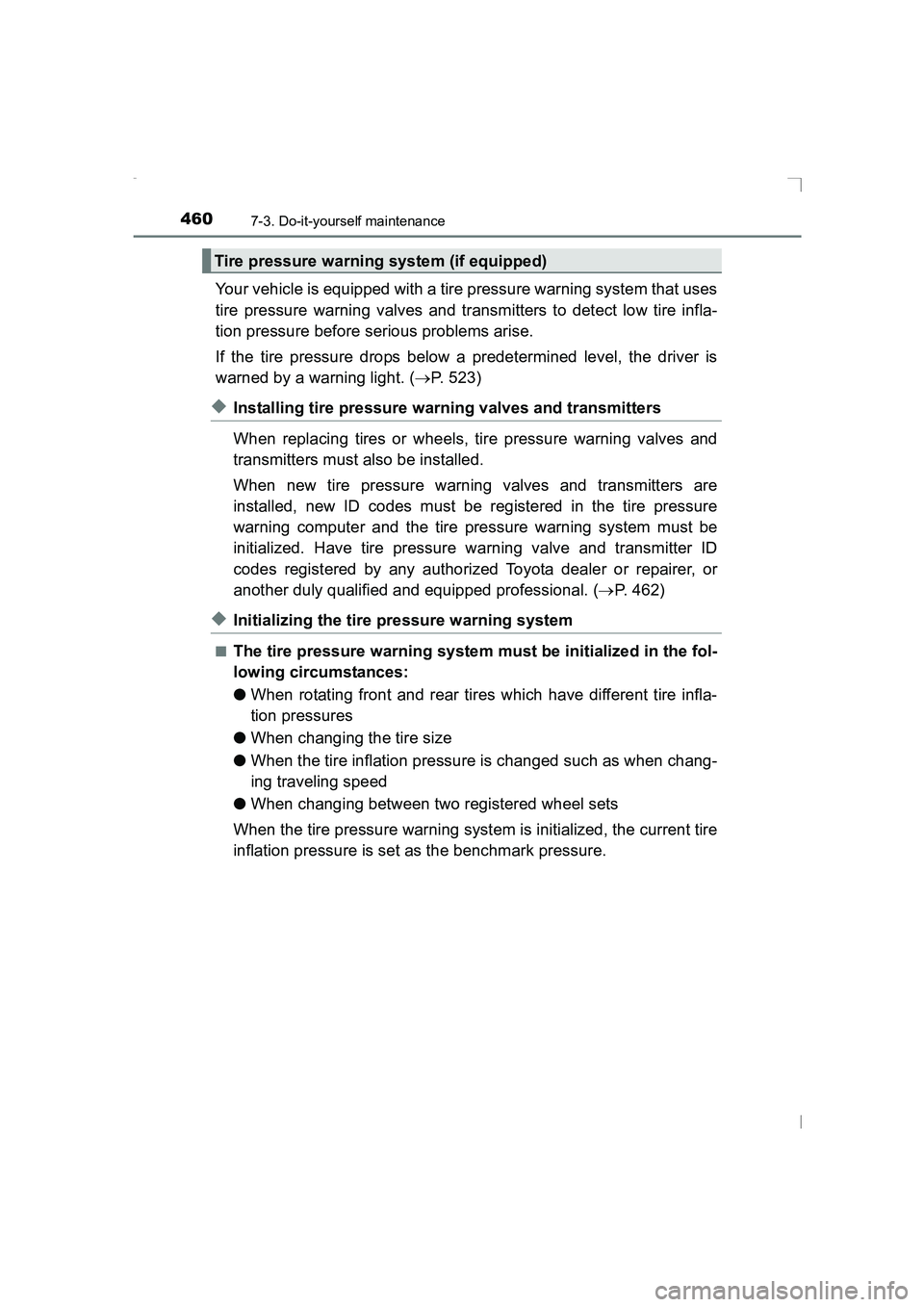
4607-3. Do-it-yourself maintenance
AVENSIS_OM_OM20C20E_(EE)
Your vehicle is equipped with a tire pressure warning system that uses
tire pressure warning valves and transmitters to detect low tire infla-
tion pressure before serious problems arise.
If the tire pressure drops below a predetermined level, the driver is
warned by a warning light. (→P. 523)
◆Installing tire pressure warning valves and transmitters
When replacing tires or wheels, tire pressure warning valves and
transmitters must also be installed.
When new tire pressure warning valves and transmitters are
installed, new ID codes must be registered in the tire pressure
warning computer and the tire pressure warning system must be
initialized. Have tire pressure warning valve and transmitter ID
codes registered by any authorized Toyota dealer or repairer, or
another duly qualified and equipped professional. ( →P. 462)
◆Initializing the tire pressure warning system
■The tire pressure warning system must be initialized in the fol-
lowing circumstances:
● When rotating front and rear tires which have different tire infla-
tion pressures
● When changing the tire size
● When the tire inflation pressure is changed such as when chang-
ing traveling speed
● When changing between two registered wheel sets
When the tire pressure warning system is initialized, the current tire
inflation pressure is set as the benchmark pressure.
Tire pressure warning system (if equipped)
AVENSIS_OM_OM20C20E_(EE).book Page 460 Thursday, January 29, 2015 1:47 PM
Page 465 of 648
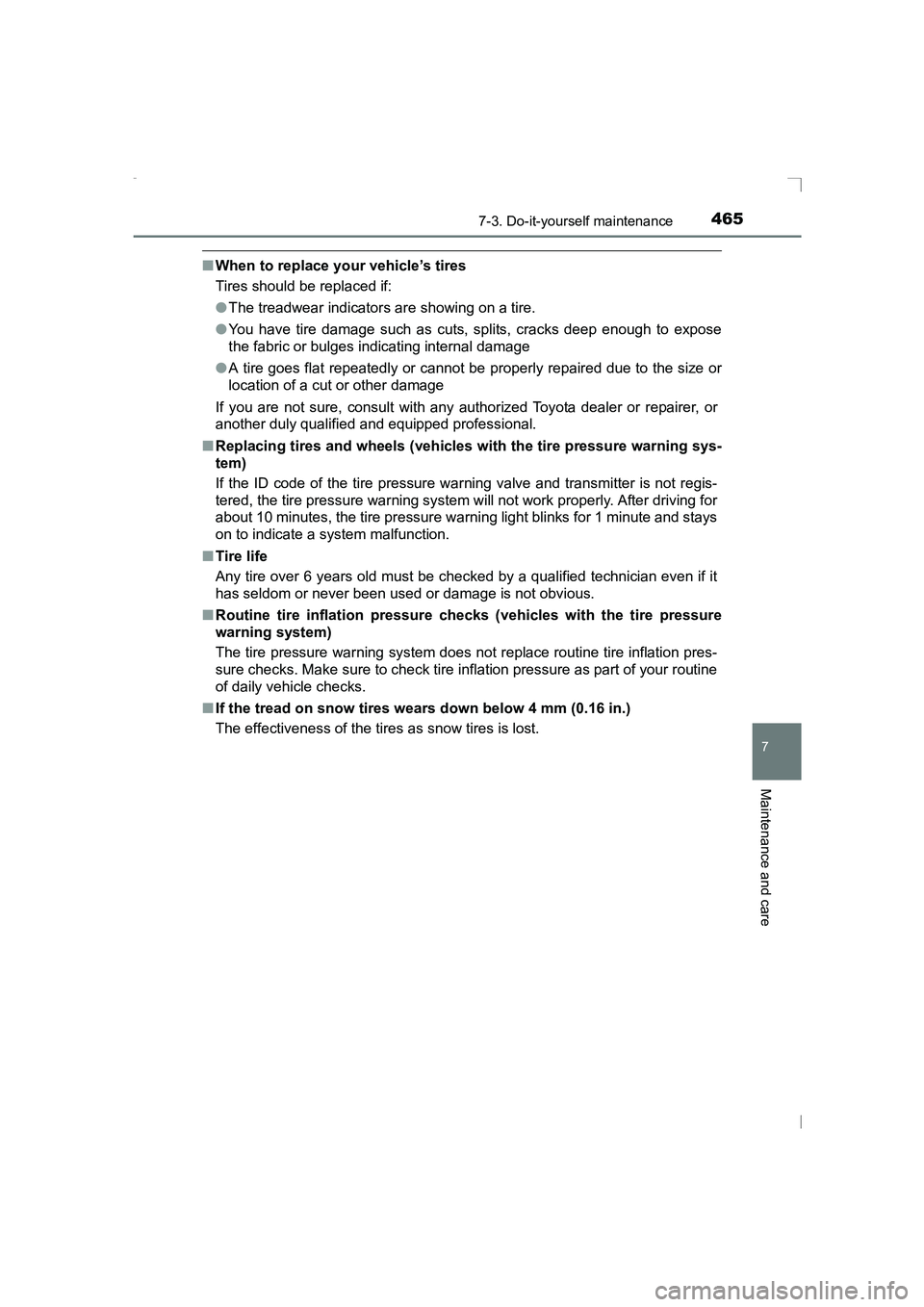
4657-3. Do-it-yourself maintenance
AVENSIS_OM_OM20C20E_(EE)
7
Maintenance and care
■When to replace your vehicle’s tires
Tires should be replaced if:
●The treadwear indicators are showing on a tire.
● You have tire damage such as cuts, splits, cracks deep enough to expose
the fabric or bulges i ndicating internal damage
● A tire goes flat repeatedly or cannot be properly repaired due to the size or
location of a cut or other damage
If you are not sure, consult with any authorized Toyota dealer or repairer, or
another duly qualified and equipped professional.
■ Replacing tires and wheels (vehicles with the tire pressure warning sys-
tem)
If the ID code of the tire pressure warning valve and transmitter is not regis-
tered, the tire pressure warning system will not work properly. After driving for
about 10 minutes, the tire pressure warning light blinks for 1 minute and stays
on to indicate a system malfunction.
■ Tire life
Any tire over 6 years old must be checked by a qualified technician even if it
has seldom or never been used or damage is not obvious.
■ Routine tire inflation pressure ch ecks (vehicles with the tire pressure
warning system)
The tire pressure warning system does not replace routine tire inflation pres-
sure checks. Make sure to check tire inflation pressure as part of your routine
of daily vehicle checks.
■ If the tread on snow tires wears down below 4 mm (0.16 in.)
The effectiveness of the tires as snow tires is lost.
AVENSIS_OM_OM20C20E_(EE).book Page 465 Thursday, January 29, 2015 1:47 PM
Page 466 of 648
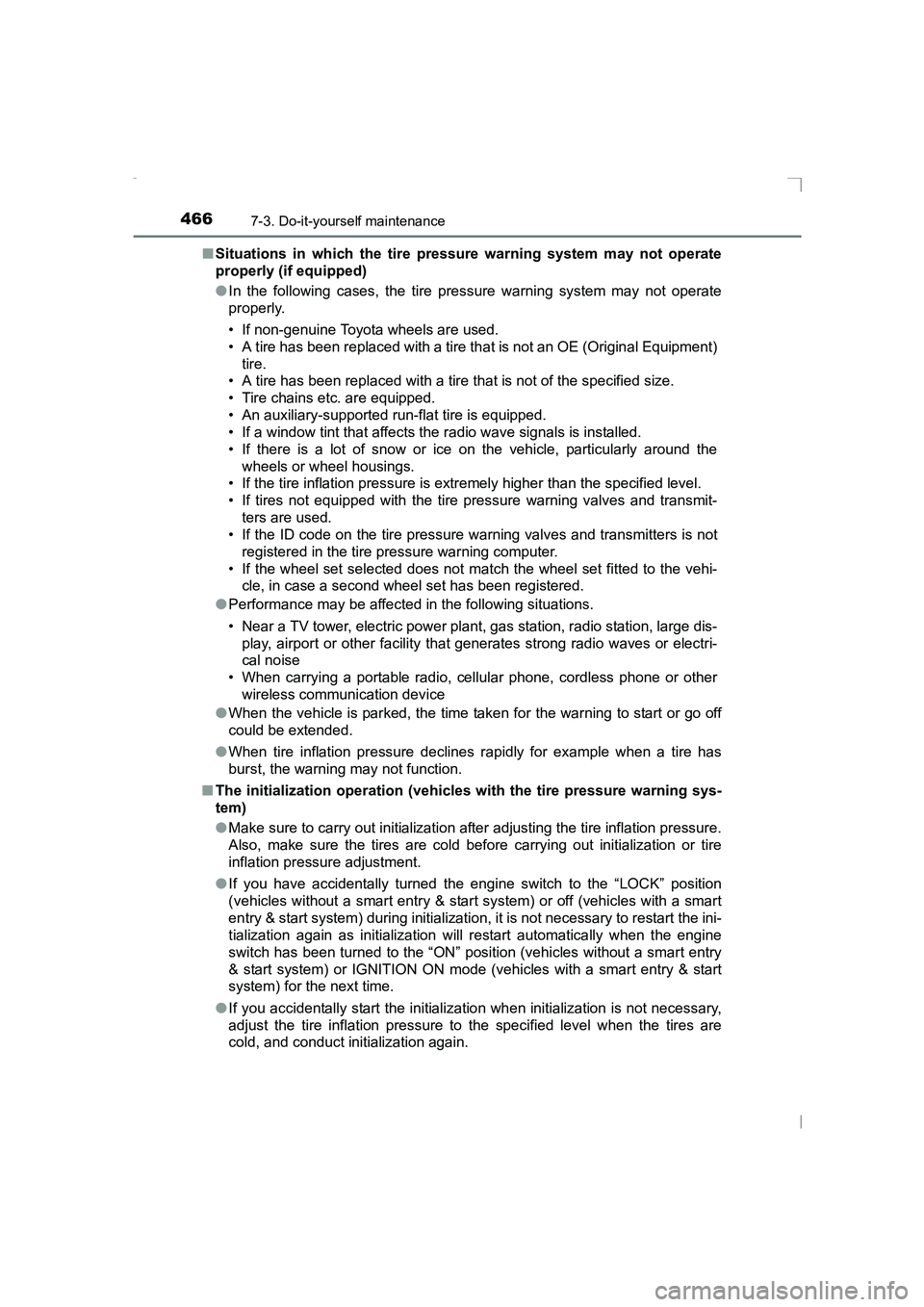
4667-3. Do-it-yourself maintenance
AVENSIS_OM_OM20C20E_(EE)■
Situations in which the tire pressure warning system may not operate
properly (if equipped)
●In the following cases, the tire pressure warning system may not operate
properly.
• If non-genuine Toyota wheels are used.
• A tire has been replaced with a tire t hat is not an OE (Original Equipment)
tire.
• A tire has been replaced with a tire that is not of the specified size.
• Tire chains etc. are equipped.
• An auxiliary-supported run-flat tire is equipped.
• If a window tint that affects the radio wave signals is installed.
• If there is a lot of snow or ice on the vehicle, particularly around the
wheels or wheel housings.
• If the tire inflation pressure is extremely higher than the specified level.
• If tires not equipped with the tire pr essure warning valves and transmit-
ters are used.
• If the ID code on the tire pressure warning valves and transmitters is not
registered in the tire pressure warning computer.
• If the wheel set selected does not match the wheel set fitted to the vehi- cle, in case a second wheel set has been registered.
● Performance may be affected in the following situations.
• Near a TV tower, electric power plant, gas station, radio station, large dis-
play, airport or other facility that generates strong radio waves or electri-
cal noise
• When carrying a portable radio, cellular phone, cordless phone or other wireless communication device
● When the vehicle is parked, the time taken for the warning to start or go off
could be extended.
● When tire inflation pressure declines rapidly for example when a tire has
burst, the warning may not function.
■ The initialization operation (vehicles with the tire pressure warning sys-
tem)
●Make sure to carry out initialization after adjusting the tire inflation pressure.
Also, make sure the tires are cold before carrying out initialization or tire
inflation pressure adjustment.
● If you have accidentally turned the engine switch to the “LOCK” position
(vehicles without a smart entry & start system) or off (vehicles with a smart
entry & start system) during initialization, it is not necessary to restart the ini-
tialization again as initialization will restart automatically when the engine
switch has been turned to the “ON” position (vehicles without a smart entry
& start system) or IGNITION ON mode (vehicles with a smart entry & start
system) for the next time.
● If you accidentally start the initialization when initialization is not necessary,
adjust the tire inflation pressure to the specified level when the tires are
cold, and conduct initialization again.
AVENSIS_OM_OM20C20E_(EE).book Page 466 Thursday, January 29, 2015 1:47 PM
Page 473 of 648
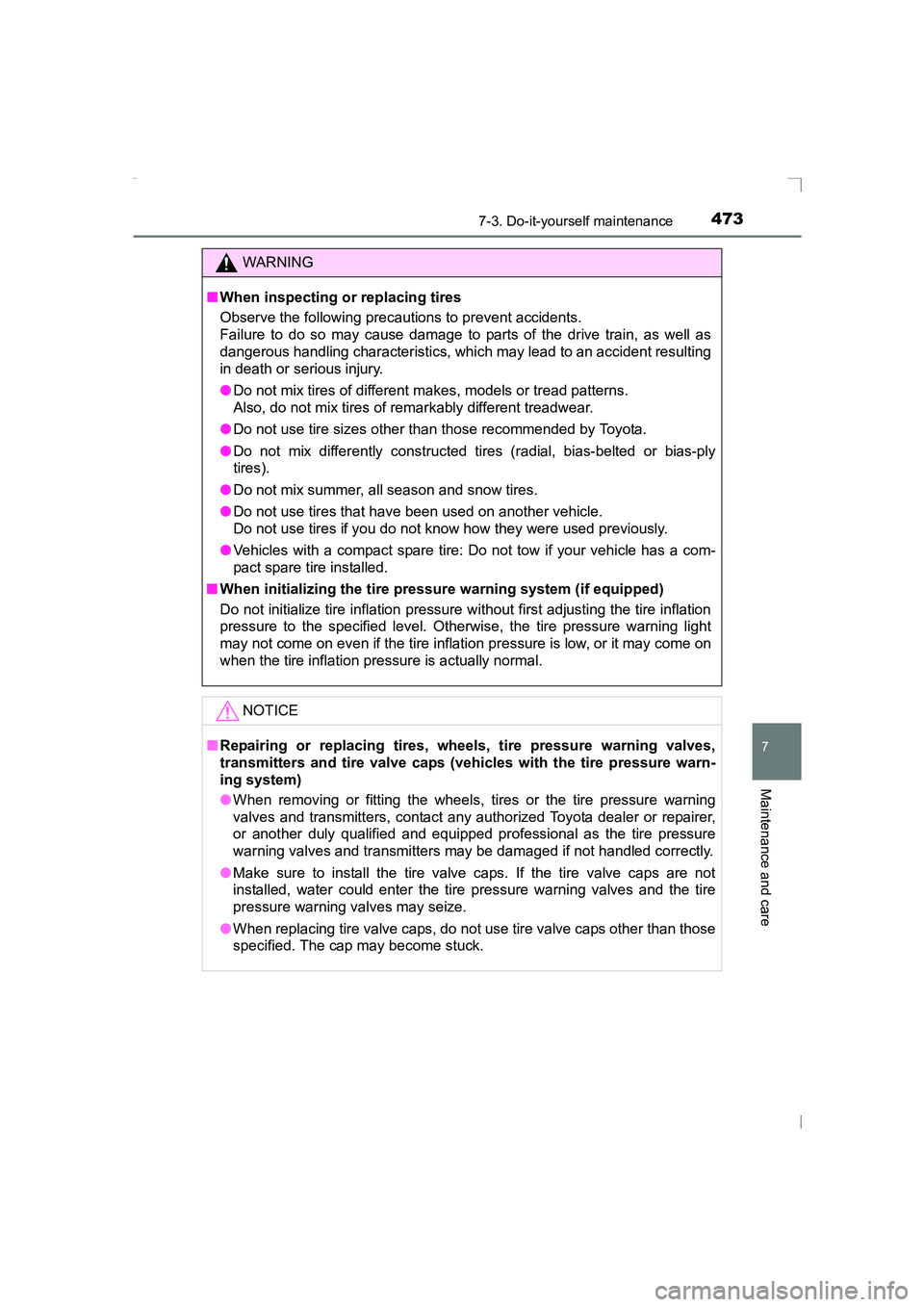
4737-3. Do-it-yourself maintenance
AVENSIS_OM_OM20C20E_(EE)
7
Maintenance and care
WARNING
■ When inspecting or replacing tires
Observe the following precautions to prevent accidents.
Failure to do so may cause damage to parts of the drive train, as well as
dangerous handling characteristics, which may lead to an accident resulting
in death or serious injury.
●Do not mix tires of different makes, models or tread patterns.
Also, do not mix tires of remarkably different treadwear.
● Do not use tire sizes other than those recommended by Toyota.
● Do not mix differently constructed tires (radial, bias-belted or bias-ply
tires).
● Do not mix summer, all season and snow tires.
● Do not use tires that have been used on another vehicle.
Do not use tires if you do not know how they were used previously.
● Vehicles with a compact spare tire: Do not tow if your vehicle has a com-
pact spare tire installed.
■ When initializing the tire pressu re warning system (if equipped)
Do not initialize tire inflation pressure without first adjusting the tire inflation
pressure to the specified level. Otherwise, the tire pressure warning light
may not come on even if the tire inflation pressure is low, or it may come on
when the tire inflation pressure is actually normal.
NOTICE
■Repairing or replacing tires, wheels, tire pressure warning valves,
transmitters and tire valve caps (vehicles with the tire pressure warn-
ing system)
●When removing or fitting the wheels, ti res or the tire pressure warning
valves and transmitters, contact any authorized Toyota dealer or repairer,
or another duly qualified and equipped professional as the tire pressure
warning valves and transmitters may be damaged if not handled correctly.
● Make sure to install the tire valve caps. If the tire valve caps are not
installed, water could enter the tire pressure warning valves and the tire
pressure warning valves may seize.
● When replacing tire valve caps, do not use tire valve caps other than those
specified. The cap may become stuck.
AVENSIS_OM_OM20C20E_(EE).book Page 473 Thursday, January 29, 2015 1:47 PM
Page 477 of 648
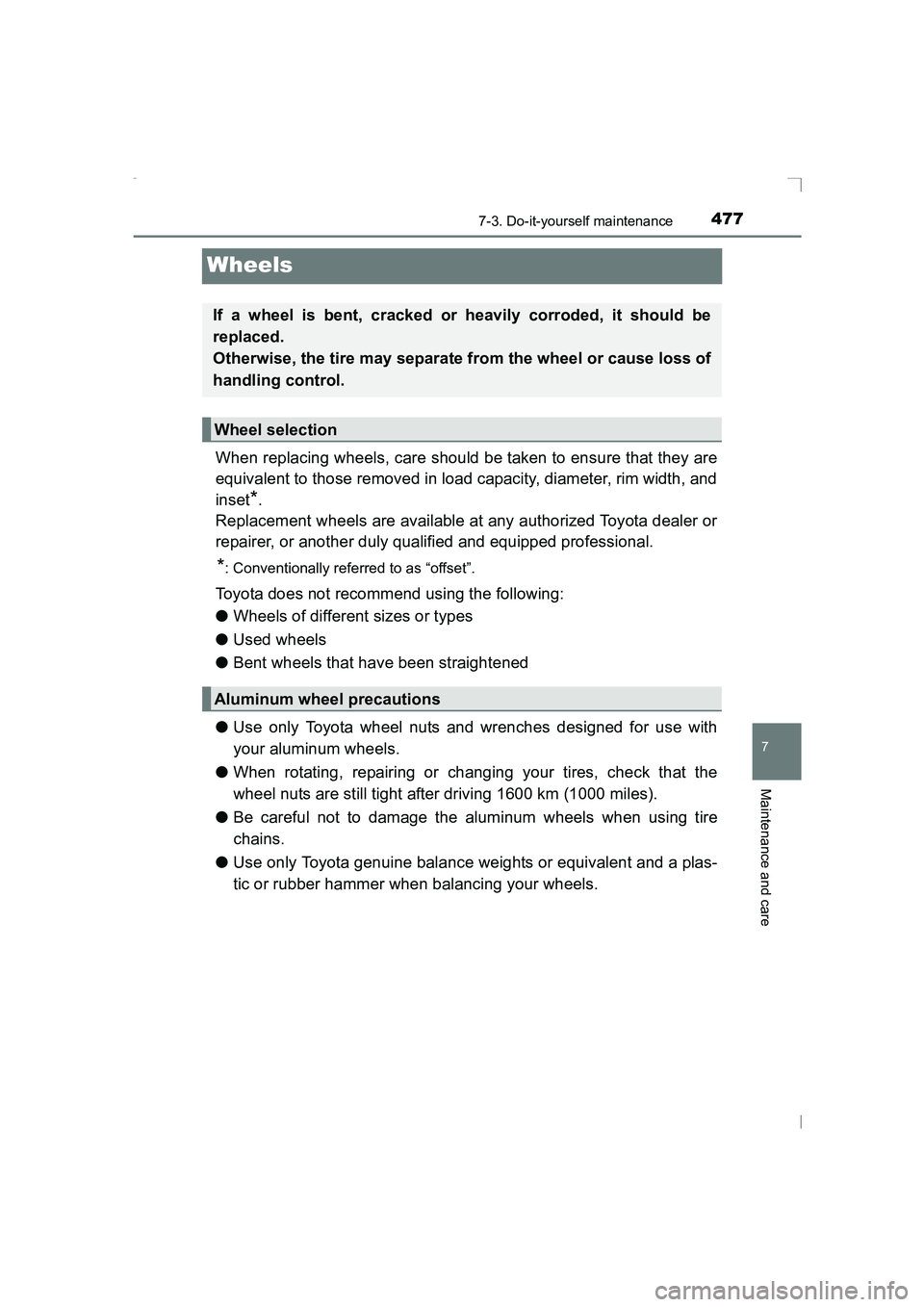
4777-3. Do-it-yourself maintenance
AVENSIS_OM_OM20C20E_(EE)
7
Maintenance and care
Wheels
When replacing wheels, care should be taken to ensure that they are
equivalent to those removed in load capacity, diameter, rim width, and
inset
*.
Replacement wheels are available at any authorized Toyota dealer or
repairer, or another duly qualified and equipped professional.
*: Conventionally referred to as “offset”.
Toyota does not recommend using the following:
● Wheels of different sizes or types
● Used wheels
● Bent wheels that have been straightened
● Use only Toyota wheel nuts and wrenches designed for use with
your aluminum wheels.
● When rotating, repairing or changing your tires, check that the
wheel nuts are still tight after driving 1600 km (1000 miles).
● Be careful not to damage the aluminum wheels when using tire
chains.
● Use only Toyota genuine balance weights or equivalent and a plas-
tic or rubber hammer when balancing your wheels.
If a wheel is bent, cracked or heavily corroded, it should be
replaced.
Otherwise, the tire may separate from the wheel or cause loss of
handling control.
Wheel selection
Aluminum wheel precautions
AVENSIS_OM_OM20C20E_(EE).book Page 477 Thursday, January 29, 2015 1:47 PM
Page 478 of 648
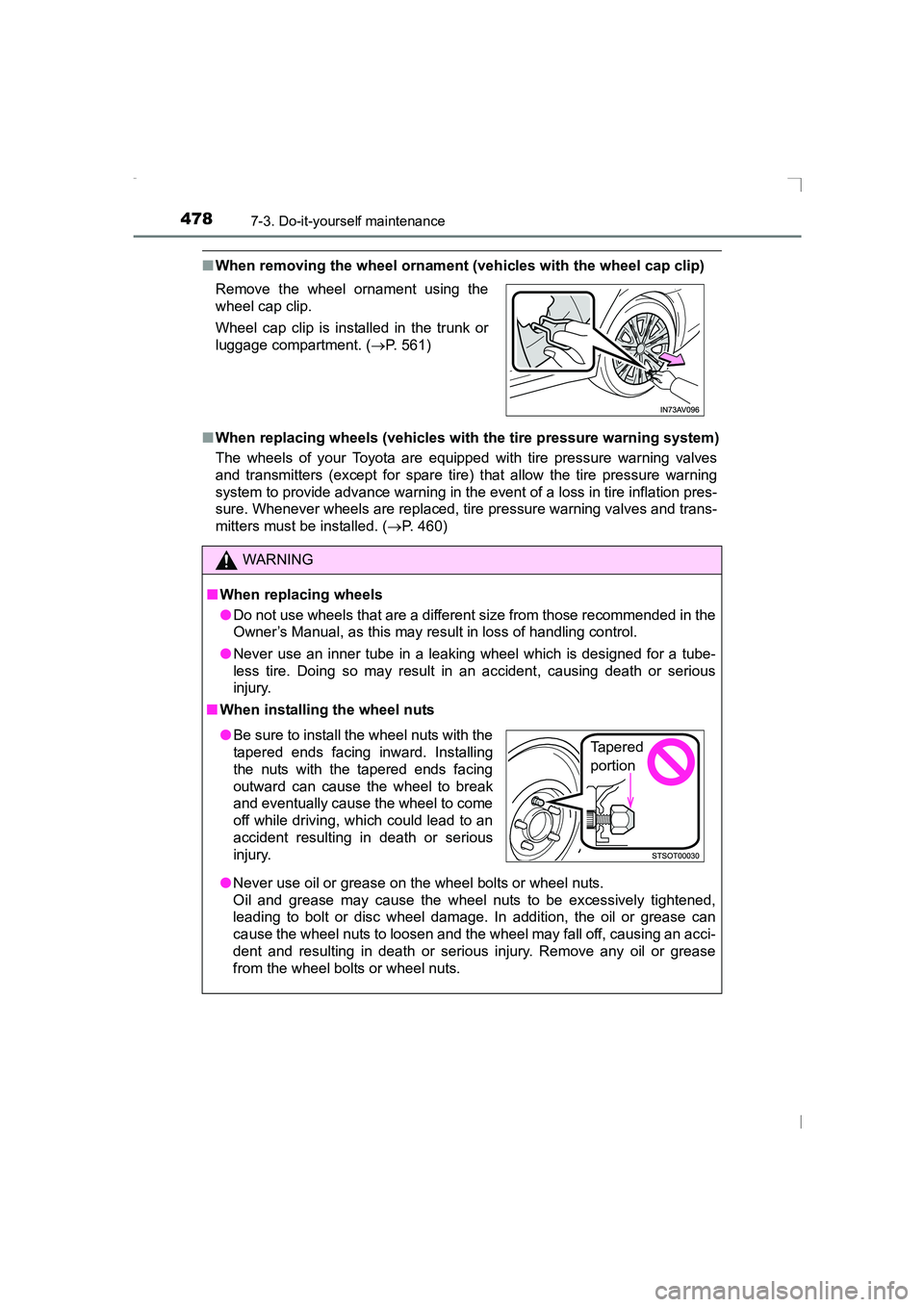
4787-3. Do-it-yourself maintenance
AVENSIS_OM_OM20C20E_(EE)
■When removing the wheel ornament (vehicles with the wheel cap clip)
■ When replacing wheels (vehicles with the tire pressure warning system)
The wheels of your Toyota are equipped with tire pressure warning valves
and transmitters (except for spare tire) t hat allow the tire pressure warning
system to provide advance warning in the event of a loss in tire inflation pres-
sure. Whenever wheels are replaced, tire pressure warning valves and trans-
mitters must be installed. ( →P. 460)
Remove the wheel ornament using the
wheel cap clip.
Wheel cap clip is installed in the trunk or
luggage compartment. (
→P. 561)
WARNING
■ When replacing wheels
●Do not use wheels that are a different size from those recommended in the
Owner’s Manual, as this may result in loss of handling control.
● Never use an inner tube in a leaking wheel which is designed for a tube-
less tire. Doing so may result in an accident, causing death or serious
injury.
■ When installing the wheel nuts
●Never use oil or grease on the wheel bolts or wheel nuts.
Oil and grease may cause the wheel nuts to be excessively tightened,
leading to bolt or disc wheel damage. In addition, the oil or grease can
cause the wheel nuts to loosen and the wheel may fall off, causing an acci-
dent and resulting in death or serious injury. Remove any oil or grease
from the wheel bolts or wheel nuts.
● Be sure to install the wheel nuts with the
tapered ends facing inward. Installing
the nuts with the tapered ends facing
outward can cause the wheel to break
and eventually cause the wheel to come
off while driving, which could lead to an
accident resulting in death or serious
injury.Tapered
portion
AVENSIS_OM_OM20C20E_(EE).book Page 478 Thursday, January 29, 2015 1:47 PM
Page 545 of 648
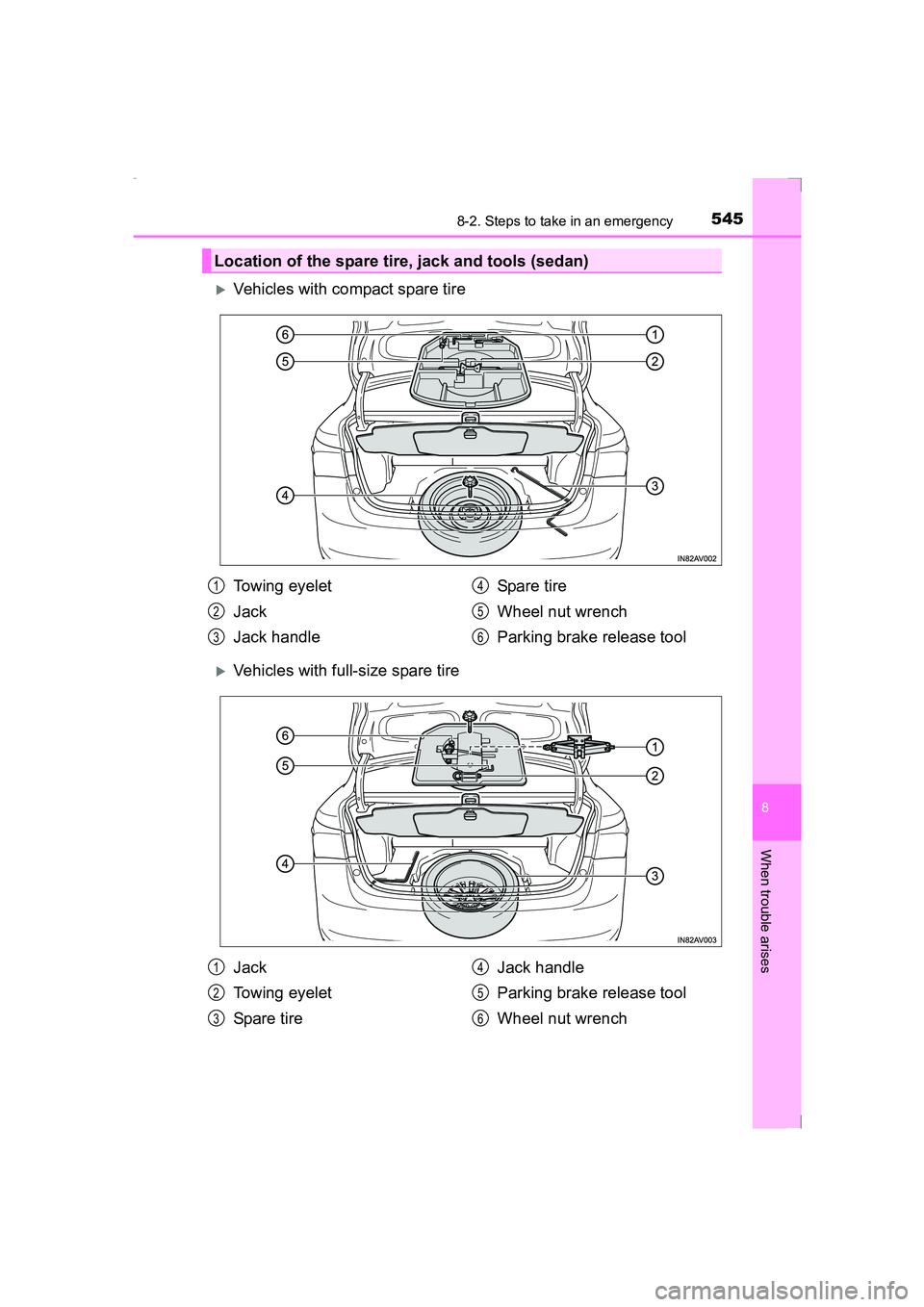
5458-2. Steps to take in an emergency
AVENSIS_OM_OM20C20E_(EE)
8
When trouble arises
�XVehicles with compact spare tire
�XVehicles with full-size spare tire
Location of the spare tire, jack and tools (sedan)
Towing eyelet
Jack
Jack handleSpare tire
Wheel nut wrench
Parking brake release tool1
2
3
4
5
6
Jack
Towing eyelet
Spare tireJack handle
Parking brake release tool
Wheel nut wrench1
2
3
4
5
6
AVENSIS_OM_OM20C20E_(EE).book Page 545 Thursday, January 29,
2015 1:47 PM
Page 546 of 648
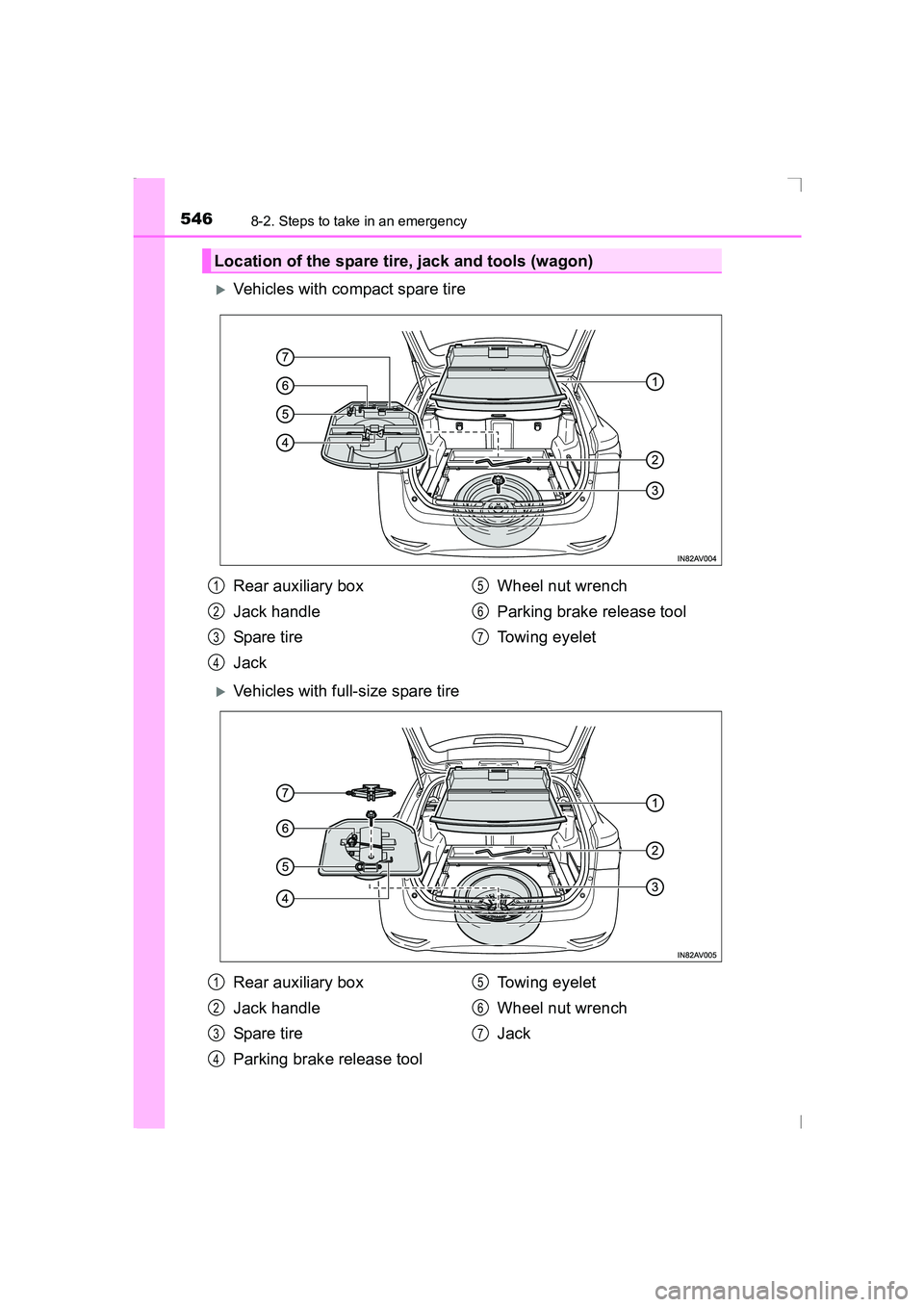
5468-2. Steps to take in an emergency
AVENSIS_OM_OM20C20E_(EE)
�XVehicles with compact spare tire
�XVehicles with full-size spare tire
Location of the spare tire, jack and tools (wagon)
Rear auxiliary box
Jack handle
Spare tire
JackWheel nut wrench
Parking brake release tool
Towing eyelet1
2
3
4
5
6
7
Rear auxiliary box
Jack handle
Spare tire
Parking brake release toolTowing eyelet
Wheel nut wrench
Jack1
2
3
4
5
6
7
AVENSIS_OM_OM20C20E_(EE).book Page 546 Thursday, January 29,
2015 1:47 PM